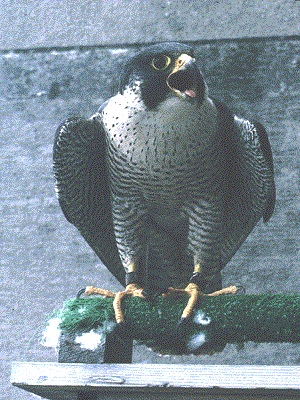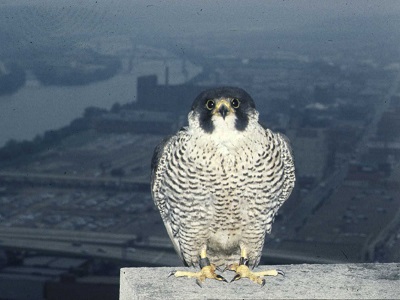Conservationists and peregrine falcons received wonderful news in September 2021 when Pennsylvania removed the bird from its threatened species list!
In 1989, Western Pennsylvania Conservancy staff members observed a pair of falcons hunting around Pittsburgh’s skyscrapers. Before that, it had been 33 years since peregrine falcons had been known to nest in the region.
The birds took flight in the hearts and imaginations of Conservancy supporters, who gave generously to support our work of partnering with the Pittsburgh building owners to create suitable nesting sites for the peregrines, first atop the Gulf Tower in Downtown Pittsburgh and later on the University of Pittsburgh’s Cathedral of Learning, with the help of WPC member Kate. St. John. The installation of web cameras drew enthusiasm from birders and the public who observed the lives of the falcons and their broods.
of partnering with the Pittsburgh building owners to create suitable nesting sites for the peregrines, first atop the Gulf Tower in Downtown Pittsburgh and later on the University of Pittsburgh’s Cathedral of Learning, with the help of WPC member Kate. St. John. The installation of web cameras drew enthusiasm from birders and the public who observed the lives of the falcons and their broods.
The Conservancy managed the nesting boxes from 1990 to 2006, at which point we turned over management to the National Aviary. The species’ regional recovery began in earnest when young birds left the two nests in Pittsburgh and ranged out as far as Niagara Falls, Toronto, Rochester, New Jersey and West Virginia to find mates and nest sites. One of the 2001 Gulf Tower young females went to nest on the cliff face next to Niagara Falls. This information is known due to coded leg bands affixed to the nestlings’ legs, or the use of telemetry units. The two Conservancy/Aviary nest sites were some of the most productive in the state, with 63 young hatching from the Gulf Tower alone between 1991 and 2010.
Other scientists and researchers began to follow and study the birds, which led to a partnership between WPC, the Pennsylvania Game Commission, the Aviary and others, resulting in a lasting conservation success and legacy for the peregrine falcon across our region. The peregrine falcon has experienced one of the most dramatic recoveries of any endangered species. In 2019, after many years on the endangered list, the peregrine falcon was upgraded to threatened-species status, and continued to see population increases, leading to its recent delisting. Pennsylvania now has at least 73 pairs of peregrines, with 10 of those being from the Pittsburgh region.

Sadly, shortly after the peregrine falcon’s delisting, scientists made a sobering announcement. The beautiful ivory-billed woodpecker and 22 more birds, fish and other species have been declared extinct. Learn more in this NPR story.
Without the efforts of the Conservancy and our partners and supporters, extinction could have been the fate of the peregrine falcon. But keeping a species from the extinction list is possible through concerted conservation efforts.
According to the PGC, the recovery of the peregrine falcon is the third high-profile raptor recovery in Pennsylvania, following the delisting of the bald eagle and osprey – demonstrating that placing a species on the endangered or threatened list is not a permanent designation, and recovery is achievable.
The Conservancy is pleased to have played a role in this majestic and fascinating bird’s local resurgence, and we thank our many generous donors who support our work of conserving and protecting special natural places, green spaces and wildlife.
###
About the Western Pennsylvania Conservancy:
The Western Pennsylvania Conservancy (WPC) enhances the region by protecting and restoring exceptional places. A private nonprofit conservation organization founded in 1932, WPC has helped to establish 11 state parks, conserved more than a quarter million acres of natural lands and protected or restored more than 3,000 miles of rivers and streams. The Conservancy owns and operates Frank Lloyd Wright’s Fallingwater, which is now on the UNESCO World Heritage List and symbolizes people living in harmony with nature. In addition, WPC enriches our region’s cities and towns through 130 community gardens and other green spaces that are planted with the help of more than 5,000 volunteers. The work of the Western Pennsylvania Conservancy is accomplished through the support of more than 9,000 members. For more information, visit WaterLandLife.org or Fallingwater.org.
